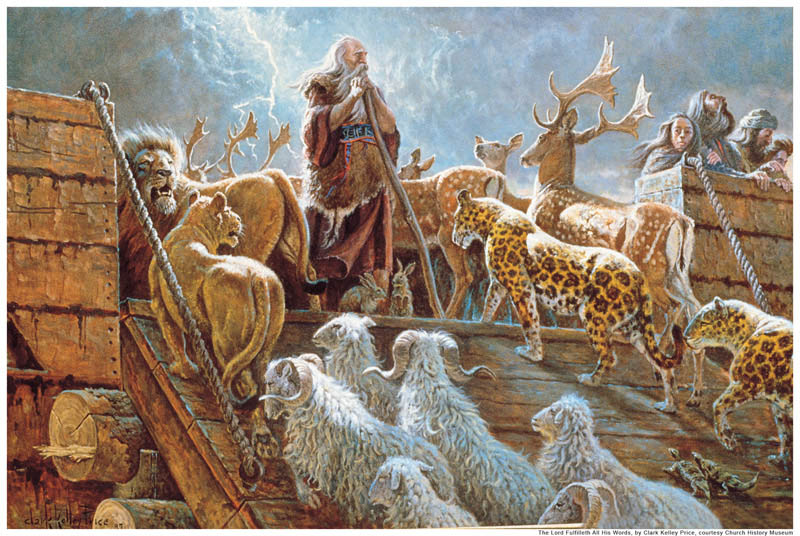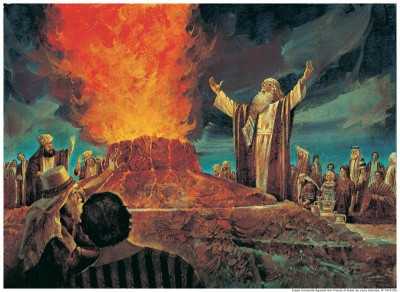 The Christian Bible has two great divisions known commonly as the Old Testament and the New Testament. The Old Testament consists of scriptures already known to the Jews of Palestine at the time of Christ. These scriptures were received by the Christian Church. The books of the Old Testament were written over many centuries and were mostly written in Hebrew. (The books of the New Testament were written over a single generation, and they were mostly written in Greek.)
The Christian Bible has two great divisions known commonly as the Old Testament and the New Testament. The Old Testament consists of scriptures already known to the Jews of Palestine at the time of Christ. These scriptures were received by the Christian Church. The books of the Old Testament were written over many centuries and were mostly written in Hebrew. (The books of the New Testament were written over a single generation, and they were mostly written in Greek.)
The word testament, when referring to the Old Testament, means covenant. The old covenant is the Law of Moses. (The new covenant is the gospel of Jesus Christ.) For Mormons, the title “Old Testament” is a misnomer, because they have a view of the gospel that extends back to Adam. They realize, and have record of, the fact that Adam understood the fulness of the gospel, knew that Christ would come in the meridian of time, and understood God’s eternal Plan of Salvation, as have all the prophets since. Thus, the role of Moses was not the beginning, but a literal restoration of lost knowledge. The Israelites he ministered to would have received of the fulness of the gospel, had they been willing. The Book of Mormon peoples, most of whom migrated to the Americas in 600 B.C., lived according to Mosaic Law, looking forward to the coming of Christ, about whom their prophets preached.
When Christ performed His ministry among the Jews, the Jews had strayed even from following the Law of Moses. Much of Christ’s teaching dealt with correcting that, and then trying to advance them to the greater blessings of the fulness of the gospel.
The Old Testament is not called thus by the Jews, since that would assume there is a New Testament, which they do not accept. They call it the tanach, an abbreviation for its three sections: the Law (torah), the Prophets (nevi’im), and the Writings (ketubim). These books were arranged by the Jews in order of importance. The Christian Bible Old Testament has a different arrangement. It was established by a Greek translation called the Septuagint. (Created for the Jews of ancient Alexandria, who could no longer read Hebrew.) The books are classified by subject matter: historical, poetical, and prophetical.
 Most of the Old Testament was written in Hebrew; portions of Daniel and Ezra were written in Chaldee, most often called Aramaic. Direct evidence for the content of the Old Testament comes from three sources — Hebrew manuscripts, ancient versions, and quotations found in Jewish writings such as the Talmud. The manuscripts consist of synagogue rolls and manuscripts for private use. Not all ancient texts agree with each other. There are differences in the Septuagint and the Samaritan Pentateuch from the Masoretic text, for instance. After the destruction of the Jewish temple in Jerusalem in 70 A.D., scholars from the Jewish school in Tiberias put forth much effort over the Hebrew text. The result is the Masoretic text. Texts that disagreed were destroyed. After that, new translations or deviations were discredited. The English King James Version (used by Mormons in English-speaking countries) follows the Masoretic text except in a very few passages. Since the Masoretic text itself is a translation agreed upon by a group of scholars long after they were written — indeed, after the ministry of Christ — the contents might not be the same as the original writings of the ancient prophets. It could be to their advantage, for instance, to delete prophecies of a savior to come. The Dead Sea Scrolls, some of which are believed to be as early as the 2nd century B.C., give evidence that the Old Testament text was corrupted at least by that time.
Most of the Old Testament was written in Hebrew; portions of Daniel and Ezra were written in Chaldee, most often called Aramaic. Direct evidence for the content of the Old Testament comes from three sources — Hebrew manuscripts, ancient versions, and quotations found in Jewish writings such as the Talmud. The manuscripts consist of synagogue rolls and manuscripts for private use. Not all ancient texts agree with each other. There are differences in the Septuagint and the Samaritan Pentateuch from the Masoretic text, for instance. After the destruction of the Jewish temple in Jerusalem in 70 A.D., scholars from the Jewish school in Tiberias put forth much effort over the Hebrew text. The result is the Masoretic text. Texts that disagreed were destroyed. After that, new translations or deviations were discredited. The English King James Version (used by Mormons in English-speaking countries) follows the Masoretic text except in a very few passages. Since the Masoretic text itself is a translation agreed upon by a group of scholars long after they were written — indeed, after the ministry of Christ — the contents might not be the same as the original writings of the ancient prophets. It could be to their advantage, for instance, to delete prophecies of a savior to come. The Dead Sea Scrolls, some of which are believed to be as early as the 2nd century B.C., give evidence that the Old Testament text was corrupted at least by that time.
In the Book of Mormon the Lord talks about the scriptures of the Jews:
Wherefore, the things which he shall write are just and true; and behold they are written in the book which thou beheld proceeding out of the mouth of the Jew; and at the time they proceeded out of the mouth of the Jew, or, at the time the book proceeded out of the mouth of the Jew, the things which were written were plain and pure, and most precious and easy to the understanding of all men (1 Nephi 14:23).
And after these plain and precious things were taken away it goeth forth unto all the nations of the Gentiles; and after it goeth forth unto all the nations of the Gentiles, yea, even across the many waters which thou hast seen with the Gentiles which have gone forth out of captivity, thou seest—because of the many plain and precious things which have been taken out of the book, which were plain unto the understanding of the children of men, according to the plainness which is in the Lamb of God—because of these things which are taken away out of the gospel of the Lamb, an exceedingly great many do stumble, yea, insomuch that Satan hath great power over them (1 Nephi 13:29).
Along with the true books there was a proliferation of false writings from apostates and from authors who for one reason or another wished to propagate some idea of theirs. From time to time decisions needed to be made as to which books were true and which were false.
Old Testament Articles
Adam and Eve in the Lone and Dreary World
Exodus 3 – The Ten Commandments
The Exodus 4: The Center of Worship
Some books have been lost. (See Lost Books.)
